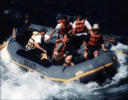6 bits
5 bits
4 bits


6 bits

5 bits

4 bits
6 bits
5 bits
4 bits
4 bits
3 bits
2 bits
CS 178 - Digital photography
Spring Quarter, 2009
Marc Levoy
The first test image (top row) is synthetic, so it should require the most number of bits to look good. To my eye, the solid glass cone lying on its side (upper-right corner) and the smoke begin to exhibit quantization artifacts, i.e. contouring, at 5 bits.
The second test image is an optically scanned photograph taken by a film camera. The optical scanner had a gamma of 1.0, thereby producing a file whose pixel values are proportional to luminance. The third row of the table shows quantization of this image. To my eye, it begins to show quantization artifacts at 5 bits, but less severely so than the synthetic image, probably because of film or digitization noise. Look in particular at the top surface of the leading edge of the raft.
The third image is an optically scanned hand-painted cartoon background. To my eye, it looks fine at 5 bits, but begins to show artifacts at 4 bits. This reduction in the number of bits is at least partially due to the more random nature of the hand painting.
Finally, the fourth image is an optically scanned pencil drawing. It does fine down to 3 bits, due mainly to the narrow spatial extent of the "zone of antialiasing", i.e. of midrange gray pixels, over which the quantization occurs. This same property allows text to be antialiased using few bits.